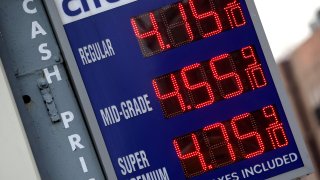
- Economists expect consumer inflation will hit a new 40-year high of 7.8%, according to Dow Jones.
- The consumer price index is the last big inflation release before the Federal Reserve meets next Tuesday and Wednesday.
- CPI was expected to peak in March, but now economists say it could do so later in the spring, depending on what happens with oil prices.
February's consumer price index is the last important look at inflation before Federal Reserve officials meet next week, and it's going to be a scorcher.
Economists expect headline inflation rose 0.7% last month, or 7.8% on an annualized basis, according to estimates from Dow Jones. That's compared to January's increase of 0.6% or 7.5% year over year. Excluding energy and food, core CPI was expected to be up 0.5%, below January's 0.6% gain. Core inflation is expected to be 6.4% year over year, up from 6%. CPI is released Thursday at 8:30 a.m. ET.
Get New England news, weather forecasts and entertainment stories to your inbox. Sign up for NECN newsletters.
The data is especially important to markets because it is the last major economic report for the Fed to consider before it begins its two-day meeting, starting Tuesday. Regardless of what the data shows, the central bank is widely expected to raise interest rates by a quarter point from zero, the first in a series of expected rate hikes.
The producer price index will be released on Tuesday, but the Fed is more concerned with the consumer price number.

"We think the market will be a little more reactive to an upside miss than a downside miss, but it is the last big data point before the Fed so you can't ignore it," said Wells Fargo's Michael Schumacher.
Money Report
Higher gas prices begin to trickle in
Some of the recent spike in gasoline prices should be included in the data, but more of the run-up should appear in March and April. Economists had expected inflation to peak in March, but now they say it could be later in the spring before it tops out. The national average price for a gallon of unleaded gasoline Wednesday was a record $4.25, up 60 cents in a week and up nearly 80 cents over the past month, according to AAA.
"Gasoline prices moved somewhat higher in the last days of February, enough to nudge my headline CPI forecast up by a tenth to +0.8%, but the bulk of the pain will be felt in March and April," said Stephen Stanley, chief economist at Amherst Pierpont.
Stanley forecasts February's headline CPI will be up 7.9% year over year. He expects March's CPI will be at least a percentage point higher, just under 9%.
"I expect the energy price spike to prove mostly temporary, so that we may see some relief by midyear, depending on how long it takes for the war in Ukraine to be resolved and how long it takes other oil and gas suppliers to step in and backfill Russia's sanctioned exports," Stanley added in a report.
Kevin Cummins, NatWest Markets chief U.S. economist, said he had expected inflation to be driven by the service sector this year, but now it looks like it will be energy, at least in the near term.
Oil has been on a tear, topping $130 per barrel earlier this week. On Wednesday, West Texas Intermediate crude futures were trading at about $109 per barrel.
Oil prices were sharply lower Wednesday on a report that the United Arab Emirates, an OPEC member, was open to production increases. But even so, as long as the Ukraine conflict continues, Russian oil will be impaired and that is likely to keep prices high, according to oil analysts.
The Fed and inflation
Cummins said the Fed should move forward with its March rate hike and could do several more before summer. "I think they're more worried about the inflation side of their mandate than they are about growth right now. The economy can sustain higher rates," he said.
He said CPI could get very hot quickly if oil prices were to move sharply higher. For instance, if oil hits $200 per barrel, CPI could be at 9.7% by April, and that is not considering how much higher oil prices could affect the price of other goods. At $125 per barrel, Cummins said inflation could be 8%.
The important number to watch in the November report is the core month-over-month increase. If it is weaker than last month, that is a positive, but if some elements of core inflation are pushing it higher, that could be worrisome for the Fed.
"The last two months were 0.6% on the core, but if they get a 0.4% that's probably a win," Cummins said. He expects the Fed to forecast four to five hikes in its new economic projections, expected to be released Wednesday.
A slower pace of core inflation could mean that some of the supply chain issues that helped push inflation higher are ebbing, Cummins said. If the semiconductor shortage eases, for example, that would help vehicle prices steady. Elsewhere, the cost of services and rents are still expected to rise.
"Rents are not going to go down. We've got them up 0.4%. If anything, you have lags. You have exceptionally strong home prices. The rental vacancy rate is low, and you have a strong labor market. That's probably the biggest thing," he said.






